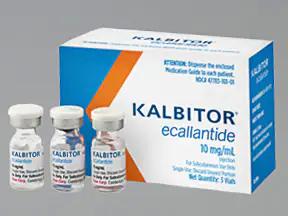Ecallantide
Generic name: ecallantide [ e-KAL-an-tide ]
Brand name: Kalbitor
Dosage form: subcutaneous solution (10 mg/mL)
Drug class: Hereditary angioedema agents
What is ecallantide?
Ecallantide is used to treat attacks of hereditary angioedema (an immune system disorder). ecallantide is for use in adults and children at least 12 years old.
Ecallantide is not a cure for hereditary angioedema.
Ecallantide may also be used for purposes not listed in this medication guide.
Ecallantide side effects
Ecallantide can cause a serious allergic reaction within 1 hour after injection. Tell your caregivers right away if you have:
-
chest pain or tightness, fast or weak heartbeat;
-
hoarse voice, tight feeling in your throat, trouble swallowing;
-
swelling of your lips, tongue, or throat;
-
swelling or redness in your face;
-
flushing (warmth, redness, or tingly feeling);
-
sneezing, runny or stuffy nose; or
-
dizziness, feeling like you might pass out.
An allergic reaction may have the same symptoms as hereditary angioedema. Your caregivers will watch you closely and will quickly treat an allergic reaction.
Common side effects of ecallantide may include:
-
stuffy nose, sore throat; or
-
skin reactions where the medicine was injected (redness, rash, itching, bruising, swelling).
This is not a complete list of side effects and others may occur. Call your doctor for medical advice about side effects. You may report side effects to FDA at 1-800-FDA-1088.
Related/similar drugs
Berinert
Berinert is used to treat acute abdominal, facial, or laryngeal hereditary angioedema (HAE) attacks ...
Kalbitor
Kalbitor is used to treat acute attacks of hereditary angioedema (HAE) in patients 12 years and ...
Orladeyo
Orladeyo (berotralstat) is used to prevent attacks of hereditary angioedema (HAE). Includes ...
Haegarda
Haegarda is an injectable protein replacement therapy that prevents swelling and attacks in ...
Takhzyro
Takhzyro (lanadelumab-flyo) is used to prevent hereditary angioedema (HAE) and reduce symptoms ...
Firazyr
Firazyr is used to treat acute attacks of hereditary angioedema (HAE) in adults. It can be ...
Ruconest
Ruconest is used to treat angioedema attacks in adult and adolescent patients with Hereditary ...
Cinryze
Cinryze (complement C1 esterase inhibitor) is used to prevent attacks of angioedema in people with ...
Icatibant
Icatibant is an injection used to treat acute attacks of hereditary angioedema (HAE) in adults. It ...
Lanadelumab
Lanadelumab injection is a monoclonal antibody used to prevent hereditary angioedema. Includes side ...
Warnings
Ecallantide can cause a serious allergic reaction within 1 hour after injection. Symptoms include wheezing, cough, trouble breathing or swallowing, itching, hives, dizziness, fainting, or swelling in your face or throat.
Before taking this medicine
If possible during an emergency, tell your caregivers you have any type of allergy. Make sure any follow-up doctor knows you received ecallantide.
You should not be treated with ecallantide if you are allergic to it.
If possible during an emergency, tell your caregivers if you are pregnant or breastfeeding.
How is ecallantide given?
Ecallantide is injected under the skin by a healthcare provider, usually in 3 separate injections.
You will be watched closely to make sure you do not have an allergic reaction to the medication.
If you still have angioedema symptoms after 3 injections, more may be given within 24 hours.
Ecallantide dosing information
Usual Adult Dose for Hereditary Angioedema:
30 mg subcutaneously in three 10 mg injections; may repeat an additional 30 mg within 24 hours if attack persists.
Usual Pediatric Dose for Hereditary Angioedema:
12 years and older: 30 mg subcutaneously in three 10 mg injections; may repeat an additional 30 mg within 24 hours if attack persists.
What happens if I miss a dose?
In a medical setting you are not likely to miss a dose.
What happens if I overdose?
In a medical setting an overdose would be treated quickly.
What should I avoid after receiving ecallantide?
Follow your doctor's instructions about any restrictions on food, beverages, or activity.
What other drugs will affect ecallantide?
Other drugs may affect ecallantide, including prescription and over-the-counter medicines, vitamins, and herbal products. Tell your doctor about all other medicines you use.
Ecallantide Biosimilars
Biosimilar and interchangeable products are biological products that are highly similar to and have no clinically meaningful differences from the reference product.
Reference products
These are biological products that have already been approved by the FDA, against which biosimilar products are compared. There is 1 for ecallantide.
Kalbitor (ecallantide) - Takeda Pharmaceuticals U.S.A., Inc.
| Formulation type | Strength |
|---|---|
| Single-Dose Vial | 10 mg/mL |
View Kalbitor information in detail.
Popular FAQ
What type of drug is Takhzyro?
Takhzyro (lanadelumab-flyo) is a human plasma kallikrein inhibitor and blocks the protein called kallikrein. Kallikrein regulates bradykinin production, a chemical that leads to inflammation (swelling). Takhzyro is a monoclonal antibody approved in the U.S. to prevent hereditary angioedema (HAE) in patients 2 years and older. Continue reading
More FAQ
More about ecallantide
- Compare alternatives
- Reviews (2)
- Side effects
- Dosage information
- During pregnancy
- Drug class: hereditary angioedema agents
- Breastfeeding
- En español
Patient resources
Other brands
Professional resources
Other brands
Related treatment guides
Further information
Remember, keep this and all other medicines out of the reach of children, never share your medicines with others, and use this medication only for the indication prescribed.
Always consult your healthcare provider to ensure the information displayed on this page applies to your personal circumstances.
Copyright 1996-2025 Cerner Multum, Inc. Version: 3.01.

